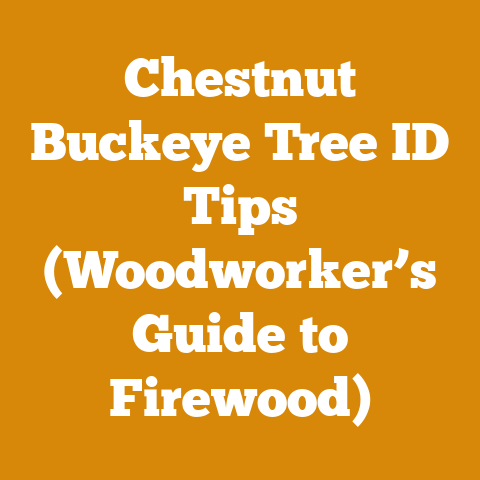Wood Burning Stove Rear Exhaust (5 Pro Tips for Easy Installation)
In the heart of winter, there’s a primal comfort in the crackle of a wood-burning stove. It’s a tradition that stretches back centuries, a connection to our ancestors who relied on wood for warmth and sustenance. Even now, in our modern world of central heating and smart thermostats, the allure of a wood fire remains strong. I can still remember the scent of woodsmoke clinging to my grandfather’s coat after he’d been out chopping, a smell that always meant warmth and stories by the fire.
But that comforting fire needs a proper home, and that’s where the wood-burning stove comes in. And while choosing the right stove is crucial, the installation is where many homeowners stumble. One of the trickiest aspects? Dealing with the exhaust. Rear exhaust stoves can be particularly challenging, but with the right knowledge and preparation, you can ensure a safe and efficient setup. Believe me, I’ve seen my fair share of installations gone wrong, from smoky rooms to downright dangerous chimney connections. That’s why I’m here to share my top five pro tips for easy rear exhaust wood-burning stove installation. Let’s get started and turn your vision of a cozy, wood-heated haven into reality.
Wood Burning Stove Rear Exhaust: 5 Pro Tips for Easy Installation
Installing a wood-burning stove, especially one with a rear exhaust, can seem daunting. But fear not! With careful planning and the right approach, you can tackle this project with confidence. These aren’t just random tips; they are hard-earned lessons from years of working with wood stoves, chimneys, and the occasional close call. I’ve seen it all, from makeshift setups that barely worked to meticulously planned installations that provided years of reliable heat.
Tip 1: Precise Measurements and Planning: The Foundation of Success
Before you even think about lifting that stove, the most crucial step is precise measurement and meticulous planning. This is where you avoid headaches down the road. I cannot stress this enough: “measure twice, cut once” applies tenfold to wood stove installation.
- Measure the Space: Start by measuring the area where you plan to install the stove. Consider the required clearances to combustible materials (walls, furniture, etc.). These clearances are usually specified by the stove manufacturer and are critical for safety. Ignoring these clearances can lead to a fire hazard. For example, a stove might require 36 inches of clearance on the sides and back if placed near a wall.
- Chimney Considerations: Determine the diameter and height of the chimney you’ll be using. The stove manufacturer will specify the correct flue diameter for your stove model. The chimney height is vital for proper draft. A chimney that’s too short won’t draw properly, leading to smoke spillage into the room. Generally, a chimney should extend at least 3 feet above the highest point of the roof and be at least 2 feet higher than any part of the building within 10 feet.
- Rear Exhaust Specifics: Pay close attention to the location of the rear exhaust outlet on the stove. Measure the distance from the floor to the center of the exhaust. This measurement is crucial for aligning the stovepipe with the chimney connector. A common mistake is assuming the exhaust is at a standard height; always double-check.
- Planning the Route: Map out the route of the stovepipe from the stove to the chimney. Minimize the number of bends in the pipe, as each bend reduces draft efficiency. A straight run is always best. If bends are necessary, use 45-degree elbows instead of 90-degree elbows, as they offer less resistance to airflow.
- Data Points: According to the National Fire Protection Association (NFPA), improper installation is a leading cause of residential fires involving heating equipment. Precise measurements and adherence to manufacturer specifications can significantly reduce this risk. A study by the Chimney Safety Institute of America (CSIA) found that over 80% of chimney fires are preventable with proper maintenance and installation.
Personal Story: I once helped a friend install a stove in his cabin. He was so eager to get it done that he rushed the planning stage. He ended up with a stovepipe that was too short and had too many bends. The result? A smoky cabin and a very frustrated friend. We had to redo the entire installation, costing him time and money. Learn from his mistake: plan, plan, plan!
Tip 2: Selecting the Right Stovepipe: Material Matters
The stovepipe is the crucial link between your stove and the chimney, and choosing the right material is paramount for safety and efficiency. Don’t skimp on this! I’ve seen people try to use thin-walled ductwork or even repurposed metal pipes, and the results are never good.
- Black Stovepipe (Single-Wall): This is typically used for connecting the stove to the chimney. It’s made of heavy-gauge steel and is designed to withstand the high temperatures of the exhaust gases. Black stovepipe radiates heat into the room, which can be beneficial, but it also requires greater clearances to combustible materials.
- Double-Wall Stovepipe (Also known as “insulated stovepipe”): This type of stovepipe has two layers of steel with an insulating air space between them. This reduces the surface temperature of the pipe, allowing for closer clearances to combustible materials. It also helps to maintain a hotter flue temperature, which improves draft and reduces creosote buildup.
- Material Grades: Look for stovepipe that meets UL 103 HT standards, which means it’s been tested and certified for use with wood-burning appliances. The gauge of the steel is also important; thicker steel will last longer and resist corrosion better. 24-gauge steel is a good minimum standard.
- Diameter Matching: Ensure the stovepipe diameter matches the stove’s exhaust outlet and the chimney connector. Using a pipe that’s too small can restrict airflow and lead to a smoky stove. Using a pipe that’s too large can result in poor draft and increased creosote buildup.
- Proper Connections: Use the correct fasteners (usually screws) to connect the stovepipe sections. Overlap the sections in the direction of the exhaust flow to prevent creosote from leaking out. Seal all connections with high-temperature silicone sealant to prevent air leaks.
- Data Points: A study by the Environmental Protection Agency (EPA) found that using properly sized and installed stovepipe can improve stove efficiency by up to 10%. Improper stovepipe can also increase the risk of carbon monoxide poisoning. According to the CSIA, corroded or damaged stovepipe is a common cause of chimney fires.
Unique Insight: I once encountered a situation where a homeowner had used galvanized steel stovepipe. Galvanized steel releases toxic fumes when heated, posing a serious health hazard. Always use black steel or stainless steel stovepipe specifically designed for wood-burning stoves. This is one area where cutting corners can have devastating consequences.
Tip 3: Achieving a Secure Chimney Connection: The Lifeline of Your Stove
The chimney connection is the most critical part of the entire installation. A faulty connection can lead to smoke leaking into your home, carbon monoxide poisoning, and even a chimney fire. This is not an area to take lightly. I’ve seen firsthand the damage a poorly connected chimney can cause, and it’s not pretty.
- Chimney Liner: If you have an existing masonry chimney, it’s essential to have it inspected by a qualified chimney sweep to ensure it’s in good condition and properly lined. An unlined or damaged chimney can allow exhaust gases to seep through the masonry, posing a fire hazard. A stainless steel chimney liner is the best option for wood-burning stoves.
- Chimney Connector: The chimney connector is the piece that connects the stovepipe to the chimney liner. It should be made of the same material as the stovepipe (black steel or stainless steel) and should be properly sized to match the flue diameter.
- Tight Seal: Ensure a tight, airtight seal between the stovepipe and the chimney connector. Use high-temperature silicone sealant to seal any gaps. The connection should be secure and stable, able to withstand the weight of the stovepipe.
- Thimble Installation: If you’re passing the stovepipe through a wall to connect to the chimney, you’ll need to install a thimble. A thimble is a metal or ceramic sleeve that protects the wall from the heat of the stovepipe. It should be installed according to the manufacturer’s instructions and with the proper clearances to combustible materials.
- Regular Inspection: Inspect the chimney connection regularly for signs of damage or corrosion. Replace any damaged components immediately. Have your chimney professionally cleaned and inspected at least once a year.
- Data Points: The CSIA estimates that 75% of chimney fires are caused by creosote buildup. A properly installed and maintained chimney connection can help to reduce creosote buildup by ensuring a strong draft and preventing air leaks. The NFPA reports that carbon monoxide poisoning is a leading cause of death in the United States, and faulty chimney connections are a common contributing factor.
Real Example: I once inspected a chimney where the homeowner had simply stuffed insulation around the stovepipe where it entered the chimney. The insulation was charred and smoldering, and the entire chimney was filled with creosote. It was a miracle the house hadn’t burned down. This highlights the importance of using proper materials and techniques for chimney connections. Never cut corners on safety!
Tip 4: Mastering the Art of Draft: The Key to a Clean Burn
Draft is the force that pulls air into the stove, fuels the fire, and carries the exhaust gases up the chimney. Without adequate draft, your stove will smoke, burn inefficiently, and produce excessive creosote. Mastering the art of draft is essential for a clean, safe, and efficient burn.
- Chimney Height: As mentioned earlier, the chimney height is crucial for proper draft. A chimney that’s too short won’t draw properly, especially in windy conditions. Generally, a chimney should extend at least 3 feet above the highest point of the roof and be at least 2 feet higher than any part of the building within 10 feet.
- Chimney Diameter: The chimney diameter should match the stove’s flue diameter. A chimney that’s too large can cool the exhaust gases too quickly, leading to poor draft and increased creosote buildup. A chimney that’s too small can restrict airflow and cause the stove to smoke.
- Air Supply: Ensure the stove has an adequate supply of air. Modern stoves often have an adjustable air intake that allows you to control the amount of air entering the firebox. Make sure the air intake is not blocked or obstructed.
- Warm-Up Draft: Sometimes, it can be difficult to establish a draft in a cold chimney. To warm up the chimney, try burning a few sheets of newspaper in the firebox before starting a fire. This will help to create an updraft and get the chimney flowing.
- Barometric Damper: In some cases, a barometric damper may be necessary to regulate the draft. A barometric damper is a device that automatically opens and closes to maintain a consistent draft, regardless of external conditions.
- Data Points: A study by the EPA found that proper draft can improve stove efficiency by up to 15%. Poor draft can also increase emissions of particulate matter and carbon monoxide. According to the CSIA, inadequate draft is a common cause of chimney fires.
Case Study: I once consulted with a homeowner who was having trouble with his wood stove. It smoked constantly, and he couldn’t get it to burn efficiently. After inspecting the installation, I discovered that his chimney was too short and was located in a sheltered area, which prevented the wind from creating a draft. We extended the chimney by a few feet, and the problem was solved. The stove now burns cleanly and efficiently.
Tip 5: Prioritizing Safety First: Your Responsibility
Wood-burning stoves can be a wonderful source of heat, but they can also be dangerous if not installed and operated properly. Prioritizing safety is your responsibility. Don’t take shortcuts or ignore safety precautions. Your life and the lives of your loved ones depend on it.
- Carbon Monoxide Detectors: Install carbon monoxide detectors on every level of your home, especially near sleeping areas. Carbon monoxide is a colorless, odorless gas that can be deadly. Test the detectors regularly to ensure they are working properly.
- Smoke Detectors: Install smoke detectors on every level of your home and test them regularly. Smoke detectors can provide an early warning of a fire, giving you time to escape.
- Fire Extinguisher: Keep a fire extinguisher nearby and know how to use it. A Class ABC fire extinguisher is suitable for most household fires.
- Clearances to Combustibles: Maintain the required clearances to combustible materials. Keep furniture, curtains, and other flammable items away from the stove.
- Floor Protection: Place a non-combustible floor protector under the stove to protect the floor from sparks and embers. The floor protector should extend beyond the stove on all sides, as specified by the stove manufacturer.
- Creosote Buildup: Have your chimney professionally cleaned and inspected at least once a year to remove creosote buildup. Creosote is a highly flammable substance that can accumulate in the chimney and cause a chimney fire.
- Safe Wood Storage: Store firewood away from the house to prevent pests and reduce the risk of fire. Stack the wood neatly and cover it to keep it dry.
- Permits and Inspections: Check with your local building department to see if you need a permit to install a wood-burning stove. Many jurisdictions require inspections to ensure the installation meets safety codes.
- Data Points: The NFPA reports that heating equipment is a leading cause of residential fires in the United States. Carbon monoxide poisoning is a significant risk associated with wood-burning stoves. The CSIA recommends annual chimney inspections to prevent chimney fires and carbon monoxide poisoning.
Personal Experience: I once responded to a house fire where the homeowner had fallen asleep with the wood stove burning. A spark landed on a nearby rug, and the house quickly filled with smoke. Fortunately, the smoke detectors alerted the family in time, and they were able to escape unharmed. However, the house was severely damaged. This incident underscores the importance of being vigilant and prioritizing safety when using a wood-burning stove.
Unique Insight: Many people think that burning seasoned wood eliminates the risk of creosote buildup. While seasoned wood does burn cleaner than green wood, it still produces creosote. Regular chimney cleaning is essential, regardless of the type of wood you burn.
Beyond the Basics: Advanced Considerations for Rear Exhaust Stoves
While the five tips above cover the essential aspects of rear exhaust wood-burning stove installation, there are some advanced considerations that can further enhance the safety, efficiency, and longevity of your setup. These are the nuances that separate a good installation from a truly exceptional one.
Understanding Draft Dynamics in Rear Exhaust Systems
Rear exhaust stoves can be more sensitive to draft issues than top-exhaust models. The horizontal run of the stovepipe can create more resistance to airflow, especially if the chimney is not tall enough or is located in a sheltered area.
- Horizontal Run Length: Minimize the length of the horizontal run of the stovepipe. The shorter the run, the better the draft. If a long horizontal run is unavoidable, consider using insulated stovepipe to maintain a hotter flue temperature and improve draft.
- Elbow Angles: As mentioned earlier, use 45-degree elbows instead of 90-degree elbows whenever possible. 45-degree elbows offer less resistance to airflow and improve draft efficiency.
- Outside Air Kit: Consider installing an outside air kit. This kit draws combustion air from outside the house, which can improve draft and prevent the stove from competing with other appliances for air. An outside air kit is especially beneficial in tightly sealed homes.
- Draft Inducer: In extreme cases, a draft inducer may be necessary. A draft inducer is a small fan that is installed in the stovepipe to boost the draft. Draft inducers are typically used in situations where the chimney is too short or is located in a difficult location.
Wood Selection and Burning Practices for Optimal Performance
The type of wood you burn and how you burn it can significantly impact the performance and safety of your wood-burning stove.
- Seasoned Wood: Always burn seasoned wood. Seasoned wood has a moisture content of less than 20%, which means it burns hotter, cleaner, and more efficiently than green wood. Green wood produces more smoke and creosote, which can lead to chimney fires.
- Wood Species: Different wood species have different heat values. Hardwoods, such as oak, maple, and birch, have higher heat values than softwoods, such as pine and fir. Choose wood species that are appropriate for your stove and your heating needs.
- Burning Techniques: Learn how to burn wood efficiently. A hot, fast fire is more efficient and produces less smoke and creosote than a smoldering fire. Avoid overfilling the firebox, as this can restrict airflow and lead to incomplete combustion.
- Top-Down Burning: Consider using the top-down burning method. This method involves loading the firebox with wood from top to bottom, with kindling and paper on top. The fire burns downward, which produces less smoke and creosote.
Data Points: A study by the Department of Energy found that burning seasoned wood can improve stove efficiency by up to 30%. Burning green wood can increase emissions of particulate matter by up to 50%.
Troubleshooting Common Rear Exhaust Stove Problems
Even with a well-planned and executed installation, you may encounter problems with your rear exhaust wood-burning stove. Here are some common problems and how to troubleshoot them:
- Smoke Spillage: Smoke spilling into the room is a sign of inadequate draft. Check the chimney height, diameter, and cleanliness. Make sure the air intake is not blocked. Try warming up the chimney before starting a fire.
- Poor Draft: Poor draft can be caused by a variety of factors, including a short chimney, a blocked chimney, a cold chimney, or a lack of air supply. Check all of these factors and take corrective action.
- Excessive Creosote Buildup: Excessive creosote buildup is a sign of incomplete combustion. Burn seasoned wood, burn hot fires, and have your chimney cleaned regularly.
- Stove Overheating: Stove overheating can be caused by overfilling the firebox, using too much kindling, or having a malfunctioning air intake. Avoid overfilling the firebox, use a moderate amount of kindling, and check the air intake.
- Backpuffing: Backpuffing is a sudden expulsion of smoke and flames from the stove. It can be caused by a sudden change in draft, a blocked chimney, or a malfunctioning damper. Check the chimney for obstructions and make sure the damper is working properly.
Conclusion: Embracing the Warmth with Knowledge and Care
Installing a rear exhaust wood-burning stove is a significant undertaking, but with careful planning, the right tools, and a commitment to safety, you can create a warm and inviting space that will provide years of comfort and enjoyment. Remember, these tips are not just theoretical; they are based on years of real-world experience and lessons learned the hard way.
Don’t be afraid to ask for help from qualified professionals. A certified chimney sweep or a wood stove installer can provide valuable guidance and assistance. And always prioritize safety above all else. By following these tips and taking the necessary precautions, you can enjoy the warmth and beauty of a wood fire without compromising your safety or the safety of your loved ones.
As I sit here writing, the scent of woodsmoke drifts in from my own stove, a reminder of the simple pleasures in life. The crackling fire, the cozy warmth, the connection to tradition – these are the things that make a wood-burning stove so special. And with a little knowledge and care, you can experience these same joys in your own home. So go forth, plan carefully, and build your own haven of warmth and comfort. The tradition awaits!






